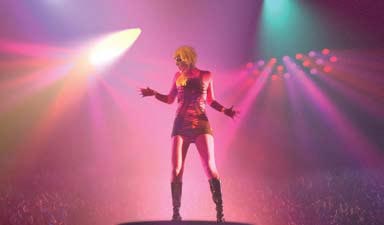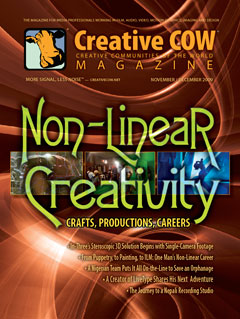Visual Effects for The Singularity Is Near: The Movie
January 1, 2010

Ramona, a virtual person, in a scene from the movie (Image: © Ray Kurzweil & Terasem Motion Infocuture Presentations)
Based on Ray Kurzweil’s New York Times bestselling book, this is a documentary scheduled for release in late 2009. It is a documentary with a storyline woven through it, similar to What the BLEEP Do We Know?
I was the on-set Visual Effects Supervisor, the Effects Art Director, and Supervised the completion of over 400 greenscreen, set extension and matte painting shots in 8 months. The elephant animation is by Miguel Fuertes.
When I say “Supervised,” I actually mean that I did most of the work myself. There was no budget to hire anyone to help me, so I just worked as quickly and as efficiently as possible. There was so much to do that, early on, I gave up attempting to do “film-quality” effects. Instead, I tried to do something a bit more stylized.
I worked on the storyline portion, which concerns a digital person named Ramona, portrayed by Pauley Perrette, as over time she develops from something similar to a Second Life avatar to a full-fledged, autonomous human. My work was mostly in the realm of greenscreen plates with digital sets, but I also developed the look transforming Pauley into Ramona’s simple avatar. There were roughly 15 sequences, of which the majority was effects shots.
One of the biggest issues on the film was the FX editorial work. The production used Final Cut Pro, but had no budget for FX editorial, so I had to do all of that myself, too.

This article on the movie's special effects was featured in the December, 2009 issue of "Creative Communities of the World" magazine
Unfortunately, Final Cut does not lend itself to manufacturing shots for effects production with handles. The “Media Managed Export” would not trim shots to length if the source file was used more than once on the timeline – it would span the shots instead. Most of what I was doing would involve every shot in a sequence as an effects shot, so I had to break the sequence down and export to separate shot directories, all by hand. I would try to structure my Shake scripts so that shots that were “same as” could be reused for each subsequent shot.
There was a great deal of rotoscoping necessary due to the unfortunate expedient of covering the lovely green floor with sand for 5 sequences. I used Mocha for my roto work, and it works fantastically. I separate the roto as sort of an articulated paper doll, with one spline for upper arm, one for lower, etc., then use the planar tracker to follow the body motion, and finally, clean up the outline.
In addition to Ramona, there was also Ramona’s digital helper, Samantha, who is represented as a sort of pixie type. For close up there was an actress, but the wide shots used a digital model I created. There were probably a hundred of those shots.